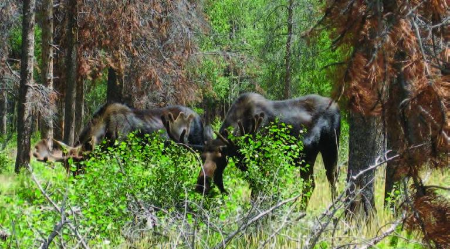From the Rocky Mountain Research Station:
Changing climatic conditions and an abundance of dense, mature pine forests have helped to spur an epidemic of mountain pine beetles larger than any in recorded history. This has raised concerns among many people that the death, desiccation, and decomposition of the overstory could have dramatic and negative consequences for affected ecosystems.
Further reading:
Further reading
Collins, B.J.; Rhoades, C.C.; Underhill, J.; Hubbard, R.M. 2010. Post-harvest seedling recruitment following mountain pine beetle infestation of Colorado lodgepole pine stands: a comparison using historic survey records. Canadian Journal of Forest Research 40:2452-2456.
Collins, B.J.; Rhoades, C.C.; Hubbard, R.M.; Battaglia, M.A. 2011. Tree regeneration and future stand development after bark beetle infestation and harvesting in Colorado lodgepole pine stands. Forest Ecology and Management. 261: 2168-2175.
Collins, B.; Rhoades, C.; Battaglia, M.; Hubbard, R.M. 2012. The effects of bark beetle outbreaks on forest development, fuel loads and potential fire behavior in salvage logged and untreated lodgepole pine forests. Forest Ecology and Management. 284: 260-268.
Clow, D.W.; Rhoades, C.C.; Briggs, J.; Caldwell, M.; Lewis, W.M., Jr. 2011. Responses of soil and water chemistry to mountain pine beetle induced tree mortality in Grand County, Colorado, USA. Applied Geochemistry doi:10.1016/j. apgeochem.2011.03.096.
Hubbard, R. M.; Rhoades, C.C.; Elder, K.; Negron, J.F. 2012. Changes in Transpiration and Foliage Growth in Lodgepole Pine Trees Following Mountain Pine Beetle Attack and Mechanical Girdling. Forest Ecology and Management, In Press.
Jolly, M.W.; Parsons, R.A.; Hadlow, A.M.; Cohn, G.M.; McAllister, S.S.; Popp, J.B.; Hubbard, R.M.; Negron, J.F. 2012. Relationships between moisture, chemistry, and ignition of Pinus contorta needles during the early stages of mountain pine beetle attack. Forest Ecology and Management 269:52-59.
Rhoades, C.C.; McCutchen, J.H. Jr.; Cooper, L.A.; Clow, D.W.; Detmer, T.M.; Briggs, J.S.; Stednick, J.D.; Veblen, T.T.; Ertz, R.M.; Likens, G.; Lewis, W. M. Jr. 2013. Biogeochemistry of Beetle Kill: Explaining a weak nitrate response. (under revision PNAS).

